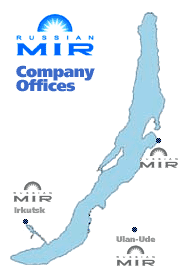Climat
Irkutsk Climate.
Winter.
The coldest period lasts from the 25th of December till the 2nd of February. The warming effect of Lake Baikal can be seen earlier. The first snow that would not melt covers the ground from the 2nd of November.
Winter weather is clear, with little wind. It snows usually in November
and December. From January till the end of winter Siberian anticyclone
is established. It is the reason for high air pressure, dry, cloudless
weather and big changes in day and night temperatures.
Spring.
The snow melts between the 1st and the 30th of April. First green grass
appears on the 29th of April. There are a lot of thunderstorms in spring. Sometimes rain is mixed with snow.
Summer.
June — 20-30 degrees Celsius
July — 20-30 degrees Celsius
August — 20-30 degrees Celsius
Autumn.
Best weather of the year comes in the second half of September. These
are warm, dry and windless days. First snow appears in the first half
of October.
The Climate of Buryatia.
Buryatia is situated in the southern part of East Siberia, in Transbaikalia. The territory stretches 600 km from north to south and 420 km from west to east. In the south it borders with Mongolia, in the west — with Tuva, in the north and north-west — with Irkutsk region, in the east — with Chita region.
The relief of the republic is mountainous. There are not much planes an all of them are situated 500-7-meters above sea level. On the territory
of the republic most of the water area of lake Baikal, the biggest
mountain lake in the world, is situated. There are a lot of rivers and they belong to lake Baikal basin. The most important rivers are: the Selenga, the Barguzin.
The soils contain podzol. Marshes and swamped areas occupy considerable
territories in big hollows between mountains. About 4/5 of the republic
are covered with forest. In the southern part there are steppes and forest-steppe. There are cedar and fir-tree forests. The total amount
of timber is 2 billion cubic meters. Fauna is also varied and rich:
sable, squirrel, hare, wolverine, bear, lynx, elk, Manchurian deer,
boar, roe deer. Barguzin sables are famous all around the world.
Climate is extreme continental with long and severe winter, with little
snow and little wind. Summer is short and hot. The temperature usually
ranges from 14 to 22 degrees Celsius in summer, from 18 to 28 degrees
Celsius below zero. Very often there are early light frosts (in the second half of August).
Baikal climate.
It's considered, that ice age at Baikal came to its end 10-12
milleniums ago. The thickness of ice here was up to 100 meters and even
more. Little glaciers are met in the mountains of the Baikal range at height of 1700 meters above sea level, of the Barguzin range — at height of 1580 meters. There is no trace of ice in Olkhon island. It even seems that there were not any because of the little level of precipitation in that place.
These years the time, during which the Lake is frozen, reduced.
Freezing-over begins later. The ice has become thinner. The water level
in Baikal is smaller nowadays that is used to be, and the climate is drier. The woods went higher in mountain tundra.
The climate of Baikal coast is a typical climate of sea coasts: in summer it is colder here than on the dry land, and in winter it is warmer. The change of temperature during the daytime on the coast of the Lake and in Irkutsk is 8-10 degrees Centigrade. In winter it is warmer at the coast than in Irkutsk in almost the same amount of degrees.
The influence of the Lake on its coast spreads to the tops of the mountains surrounding the lake. On average 500 meters during the warm
season the warm influence of Baikal reaches 2.5 km above the surface of the Lake, and about 30-50 km — along the valleys of its rivers. If wind
blows from the side of Baikal — in Irkutsk it is sunny. There are a lot of winds at Baikal.
Gornaya, or north-western wind; Barguzin, or Verkhovik; Angara, or north-eastern wind; Kultuk, or south-western wind; Shelonnik, or south-eastern wind.
The maximum speed of the wind is 40 meters per second. In Olkhon winds
are especially strong. They are blowing there form the end of October
till December, for about 50 days at all.
Freezing-over of Baikal starts approximately at the 21st of December;
ends at the 16th of January. It demands a month to freeze. Bays and creeks are first to be cover with ice. There are cases of Listvyanka
getting frozen only at the beginning of February. If the Lake gets
frozen earlier, the ice is thicker. Ice melting is fuller. Ice destruction in the southern basin happens in April. Baikal is totally
cleared from ice in May. The northern part of the Lake freezes a month
earlier and melts a month later. Baikal gets frozen totally but for 15-20 km in the source of the Angara river.
In winter on the windward sides of the rocks icy outgrowths appear.
Very often they are met on the rocks of Horse Head Cape in the Little
Sea and a place in Olkhond island to the north of Uzur Pad'.
The atmosphere above the Lake is very transparent. You can vividly sea mountain peaks at the distance of 200 km and more.
27.05.2008
|


Our address
670000, Ulan-Ude,
Profsoysnaya Street, 31
Tel/Fax Ulan-Ude:
8 (3012) 216-177
664025, Irkutsk,
Rossiyskaya Street, 6. Office 2
Tel/Fax Irkutsk:
8 (3952) 342-043
ICQ: 616-858-802
Skype: russianmir
e-mail: russian-mir@yandex.ru
Certif. РОСС.RU.АЮ03.У00830

|



